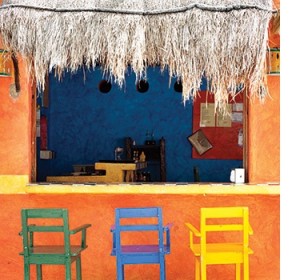 Young, vibrant and volatile – Latin America is a land of opportunity for premium spirits, be they international or home-grown, discovers Tom Bruce-Gardyne.
Young, vibrant and volatile – Latin America is a land of opportunity for premium spirits, be they international or home-grown, discovers Tom Bruce-Gardyne.
Many a Caipirinha was mixed in bars around the world as people gathered infront of TVs to watch Brazil vs Germany in the World Cup semi-final on 8 July last year. Perhaps the less said about the match the better given what happened to the host nation, but the World Cup certainly gave a boost in exports for Brazil’s beloved national spirit.
“In Brazil cachaça completely dominates consumption,” says Dan Mettyear, who monitors the country as market analyst for IWSR. He has tracked the cane-based spirit’s decline as it lost 12.5 million cases in the five years to 2012. Last year it slipped another 2% to 78.5m cases. Meanwhile, vodka has been growing steadily to 8.5m cases in 2013, partly because Brazilian barmen have been shifting from the Caipirinha to the vodka-based Caiprioska.
“Cachaça has quite a negative, low-life image in Brazil,” says Mettyear, who points out: “the term ‘cachaçaceiro’, or cachaça-lover, basically means drunkard. As the middle classes expanded they were desperate to try something new and vodka was an easy switch for consumers.” You can buy a bottle of the top-selling Cachaça 51 for under R$7 (US$3) in a Sao Paolo supermarket. Locally-distilled Smirnoff Red might be three times as much, but it’s infinitely more accessible than Johnnie Walker Red which, according to Mettyear, costs around R$70 (US$30).
Economic squeeze
The Brazilian economy officially entered recession in late August, and disposable income is being squeezed hard. However Diageo, the lead player within international spirits, hasn’t seen much of a slowdown yet. Tania Cesar, the firm’s marketing director for Brazil, Uruguay and Paraguay, says: “The most premium part of each spirits category is what’s growing fastest, and of all categories, Scotch whisky is doing best.” Quoting Nielsen, she puts Diageo’s growth in Scotch at 28% for the year to July.
Despite its price, Brazil is a huge market for Johnnie Walker, and consumers who have scaled the heights to get there are reluctant to retreat. It seems they would rather max-out their credit lines than risk being caught ordering a less prestigious brand in a bar. “It is quite an image-conscious country and people don’t want to lose face,” says Mettyear.
Whisky is traditionally stronger in the northeast of the country where locally-bottled Teachers and Passport are big players in standard Scotch. Both these Pernod Ricard brands face growing competition from White Horse which jumped 55% in the year to July, according to Cesar. For her, the biggest challenge is to increase the market penetration of international spirits, which was one reason Diageo spent US$450m buying Ypióca, Brazil’s best-selling premium cachaça.
Vodka prospects
Meanwhile vodka “is a very dynamic category with double-digit growth,” says Cesar, who claims Smirnoff has a 60% share. Rival Skyy is also doing well with half-year growth of 25% according to Gruppo Campari’s marketing manager in Brazil, Juliana Boteon. The group recently added Wild Turkey, Bulldog gin and Espolòn Tequila among others to its premium portfolio in what it sees as a key emerging market. This chimes with Mettyear’s upbeat assessment for international brands in Brazil. “There’s still plenty of potential for growth, despite the recent slowdown. It has been very concentrated around Rio, but there are lots of growth opportunities in interior cities as Brazilians move inland away from the congested coast. So I’d say expanding distribution will be the next phase.”
One spirit not doing so well in Brazil is rum, where the declining, Pernod-owned Montilla dominates the category. Havana Club’s marketing manager, Nick Blacknell, has set his sights elsewhere. “At the moment there are easier battles to fight in markets without such strong local brands, and where there’s a culture of imported quality rum,” he says. This makes countries like Chile and Argentina much more exciting. “Ten to 15 years ago, Pernod Ricard in Chile really started to invest heavily in Havana Club and the dividends have paid off,” he explains. “It’s the market leader there and its rivals are other dark rums like Abuelo and Flor de Caña, not Bacardi.”
Ruling rums
He believes Bacardi is seen as a white spirit in the region, and says: “We hardly sell any white rum at all in South America, where we basically start with Especial and go upwards.” A key focus is Havana Club 7, as it is in Mexico where “it competes at the same price as 12-year-old Scotch,” says Blacknell. “We took a deliberate super-premium strategy, and it’s paying off well.”
Meanwhile, across the water in its homeland of Cuba, Havana Club sells one million cases a year, which he reckons “is about 60% of what would be recognised as bottled, quality rum.” These Cuban roots give the brand its strong Latin credentials that resonate across the entire region. Looking south to markets like Argentina, Colombia and Peru, he says: “We can be super-premium and we can also play to the values of Latin Americans. I strongly believe that’s where the future’s going to lie.”
Diageo’s marketing manager in Mexico, Jeremy Kanter, feels the country’s rum market was pretty stale under Bacardi Blanco’s rule, until Captain Morgan came along. “The Captain has injected a huge bundle of energy, relevance and attitude. It’s really connected with 18-28-year-olds,” he says, adding that the brand has stolen 11% of Bacardi’s share in five years. In the super-premium rum category, Diageo is focused on its Guatemalan brand Zacapa.
Source: The Spirits Business
